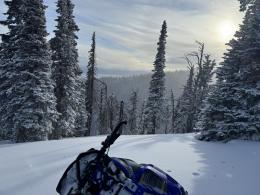Good morning. This is Dave Zinn with the Gallatin National Forest Avalanche Forecast on Tuesday, January 9th at 7:00 a.m. This information is sponsored by Ride Rasmussen Style, Werner Wealth Management (Advisors with DA Davidson) and the Upper Yellowstone Snowmobile Club. This forecast does not apply to operating ski areas.
Mountain temperatures range from around 0 degrees F near West Yellowstone, Island Park, and Cooke City to the mid-teens F near Bozeman and Big Sky. Winds are 15-30 mph with gusts up to 55 mph from the southwest to northwest, and there is 1-2” of new snow in the Bridger Range and near West Yellowstone, Island Park, and Cooke City.
Today, temperatures will be in the teens to 20s F with 20-35 mph winds from the west to southwest. By tomorrow morning, the mountains around Island Park, West Yellowstone, and Cooke City will receive 5-10” of new snow, with 2-5” around Big Sky and Bozeman.
All Regions
Strong winds are transporting recent snow into thick drifts on wind-loaded slopes where dangerous avalanche conditions exist, and human-triggered avalanches are likely. New snow today will add fuel to this fire. Human-triggered avalanches are possible in non-wind-loaded terrain where the slabs of recent snow are sitting on persistent weak layers.
Mountain winds increased yesterday afternoon and will continue to blow 20-35 mph from the west to southwest throughout the day. Avoid steep slopes where strong winds are transporting 4-9” of snow that fell across much of the advisory area, and up to 16” in the Centennial Range through the weekend. Today’s snow will amplify instabilities. Wind-loaded slopes will be sensitive to human triggers and likely to produce avalanches 1-2+ feet deep, large enough to injure or bury backcountry travelers. A natural avalanche two days ago on West Woody Ridge near Cooke City (details and photo), and numerous small, human-triggered avalanches three days ago in wind-loaded terrain at Buck Ridge (video) are recent examples of this type of avalanche problem. Expect to find these drifted slopes at upper and mid-elevations. Natural avalanches, shooting cracks and collapsing are red flags indicating instability.
Whether wind-affected or not, recent snow fell on a snowpack with multiple weak layers that can fail and avalanche. Assessing and discussing these weak layers has been a staple of our field days across the advisory area (23-24 Field videos). Riders, skiers and climbers have submitted many greatly appreciated observations documenting the nearly universal distribution of this season’s weak snowpack structure (snow and avalanche observations page). Knowing that weak layers are likely under your feet, dig down and test for any associated instability before considering travel on terrain steeper than 30 degrees.
The danger is rated CONSIDERABLE on wind-loaded slopes. The danger is rated MODERATE in non-wind-loaded terrain but will increase as today’s snowstorm adds weight and stress to buried weak layers.
If you venture out, please fill an observation form. It does not need to be technical. Did you see any avalanches? How much snow is on the ground? Was the wind moving snow? Simple observations are incredibly valuable. You can also contact us via email (mtavalanche@gmail.com), phone (406-587-6984), or Instagram (#gnfacobs).
Upcoming Avalanche Education and Events
Our education calendar is full of awareness lectures and field courses. Check it out: Events and Education Calendar.
Every weekend in Cooke City: Friday at The Antlers at 7 p.m., Free Avalanche Awareness and Current Conditions talk, and Saturday from 10 a.m.-2 p.m. at Round Lake Warming Hut, Free Rescue Practice.
We offer Avalanche Fundamentals with Field Session courses targeted towards non-motorized travelers in January and one geared towards motorized users. Sign up early before they fill up.
King & Queen 2024, 3 February 2024. Form a team or sign up individually to hike laps on the Bridger Bowl ridge to fundraise for the Friends of the Avalanche Center.
Loss in the Outdoors is a support group for those affected by loss and grief related to outdoor pursuits. Check out the link for more information.
Here’s a quick read, The Invisible Hands of Avalanche Work, an interview with GNFAC forecaster, Doug Chabot.


